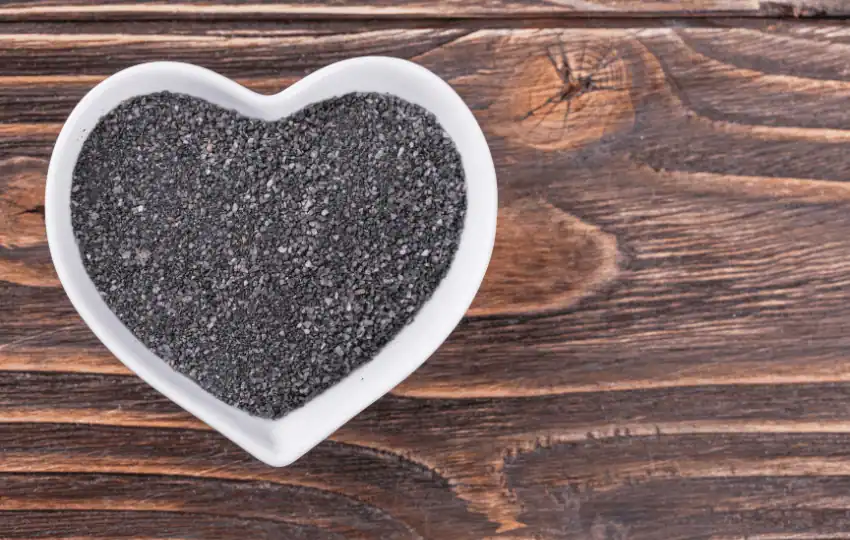Black salt, or kala namak, is rock salt used in Indian cuisine to add a salty, pungent flavor.
It’s also popular among vegans and vegetarians because it contains high sulfur. Kala namak has a distinct flavor and smell that adds a unique depth to dishes.
Unfortunately, black salt is not always easy to find. So, —there are plenty of great substitutes that will give you the same flavor profile.
Let’s look at the best black salt substitutes available and where you find them most.
In short "What can I use in place of kala namak?"- Rock salt, Himalayan Salt, Black Lava Salt, Sendha namak, Chaat Masala, Fleur de sel, Sel Gris, Maldon Salts.
What is Black Salt, and What does black salt taste like?
Black salt, also known as Kala Namak, is an Indian volcanic rock salt. It has a strong sulfurous egg smell, and its unique flavor may remind some people of hard-boiled eggs.
The taste is slightly bitter and often described as being somewhat similar to smoky bacon or ham.
Uses of Black Salt A.K.A Kala Namak
Black salt is commonly used in South Asian cuisine for flavoring curries, salads, chutneys, and raita (yogurt sauces).
Additionally, it can be used in desserts such as kheer (a rice pudding) or halwa (an Indian sweet). It can also be added to drinks like chaas (buttermilk) to enhance the flavor.
Black salt is known for its health benefits, such as aiding digestion, reducing water retention, and relieving flatulence. It contains trace amounts of iron and other minerals, which is beneficial.
10 Best Black Salt Substitutes
1. Rock Salt

Rock salt is also known as Halite or Himalayan rock salt. Due to its health benefits, it has become increasingly popular over the past few years.
It has a slightly different flavor than regular table salt, is similar to Kala Namak, and is said to contain more minerals than its counterpart.
It can also be used as a 1-to-1 substitution for black salt in recipes and is easy to find online or in specialty stores such as health food stores.
2. Black Lava Salt
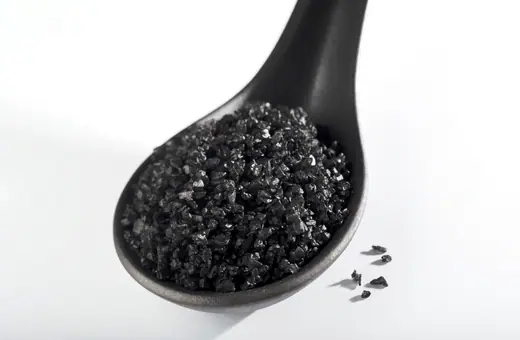
Another similar-looking salt that has many health benefits as Black salt is Black Lava Salt.
Black Lava Salt is a unique seasoning blend combining traditional sea salt’s flavor and health benefits with activated charcoal.
Activated charcoal helps to absorb toxins in the body, making it an ideal seasoning for those looking to improve their overall health and well-being.
Black Lava Salt also adds a smoky, salty flavor to dishes like grilled fish or roasted vegetables. It’s easy to sprinkle on top of food or incorporate into rubs, marinades, and sauces.
You can find Black Lava salt online or at Salt Aisle in the market. Black Lava Salt is quite expensive than Black Salt.
3. Himalayan Black salt
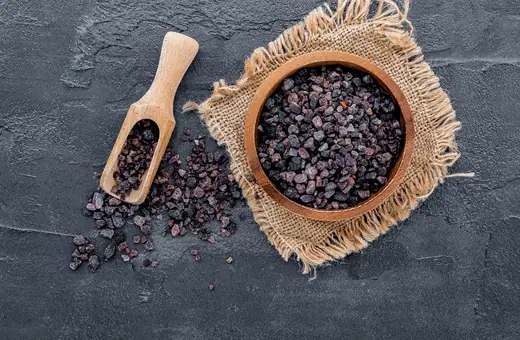
Try Himalayan Black Salt, Also known as Kala Namak; this salt is mined from the foothills of the Himalayas and has a strong sulfuric flavor due to its high iron sulfide content.
You can use this same way as black salt in many Indian dishes to add an extra layer of flavor.

4. Himalayan Pink Salt
Himalayan pink salt is the closest substitute for black salt in flavor and aroma.
Himalayan pink salt has a milder flavor than black salt but still offers that distinctive salty taste with hints of sulfur and minerals.
Himalayan pink salt can be found in most grocery stores or online, like amazon, so it’s an easy alternative to black salt if you can’t find it at your local market.
5. Pinch of Chaat Masala
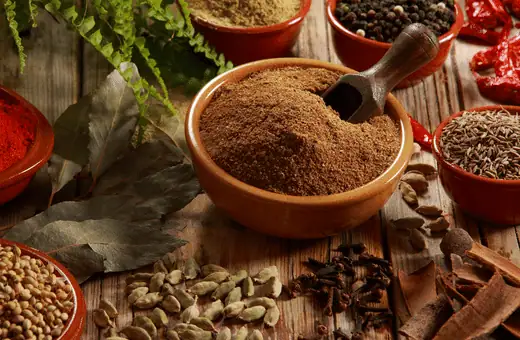
Adding a pinch of chaat masala to a dish is an excellent way to replace black salt.
Chaat masala combines spices, including cumin, coriander, dried mango powder, black pepper, red chili powder, and rock salt.
Its flavor profile is tangy and slightly salty, with a hint of sweetness from the mango powder.
Chaat Masala’s sour and savory combination works especially well as an accent in both vegetarian and non-vegetarian dishes such as curries, kebabs, and tikkas.
You can also be sprinkled over snacks like popcorn or papdi chaat to provide a flavorful kick. In addition to its uses as a condiment or seasoning.

6. Sendha namak (Salt)
Sendha namak is a type of rock salt known for its distinct flavor and texture, which adds depth and complexity to dishes.
Sendha namak is an integral part of Indian cuisine and has been used since ancient times and has a similar taste profile to kala namak but is less salty.
It can season many dishes, including curries, daals, rice dishes, vegetables, meats, and even desserts!
Sendha namak is also used in different snack items – like samosas and kachoris – making them both flavourful and crunchy.
The best part is that it is way cheaper than other options.
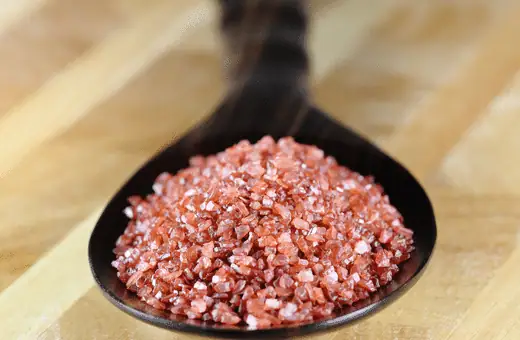
7. Alaea salt or Hawaiian red salt
Another great option to switch to black salt is Alaea Salt from Hawaii.
Hawaiian red salt is pinkish-red unrefined sea salt that gets its unique hue from volcanic clay called Alaea, which gives it a slightly earthy mineral taste that’s great for seasoning seafood and pork dishes.
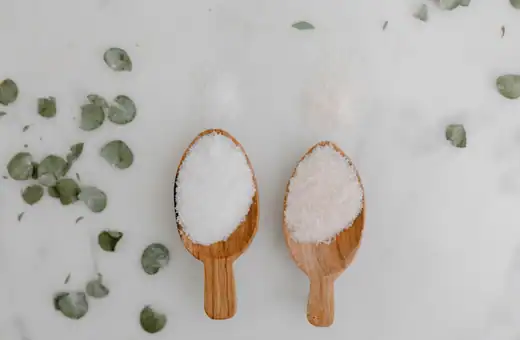
8. Fleur de Sel
Fleur de sel is another type of rock salt and makes a great substitute for black salt due to its mild yet briny taste.
Harvested from evaporated seawater ponds near Brittany, France, this light grayish-white salt has large crunchy flakes with a delicate briny flavor.
Use- 1: 1/2 ratio, which means 1 teaspoon fleur de sel salt for 1/2 teaspoon of kala namak.
Unlike black salt, fleur de sel has no sulfuric compounds, so it won’t give your dish the same pungent aroma as black salt but can still provide a unique salty taste with hints of minerals that will make your dish stand out from the rest!
However, fleur de sel still offers a nice salty flavor that works well in many dishes and adds an elegant finishing touch to salads and desserts.
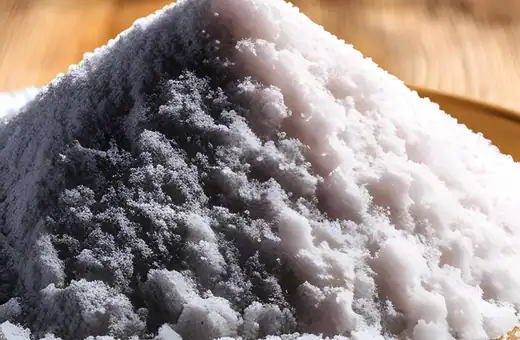
9. Sel Gris
A type of French grey sea salt, Sel Gris is harvested off the coast of France in the Celtic Sea by hand using traditional methods. It is similar to fleur de sel.
Use- 1/2 amount of Sel Gris.
The moist crystals have a mild briny flavor, making them a perfect addition to many dishes when you need to add salt at the end.
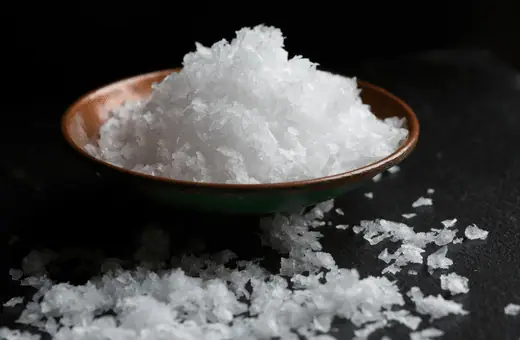
10. Maldon Salts
Last but not least, swap black salt with Maldon Salts. It is pyramid-shaped flakes from England’s Essex coastline. It has a mildly sweet and briny taste, making them ideal for finishing salt in chips, grilled meats, fish, or roasted vegetables.
Bonus Part:
So there you go, the 10 best substitutes for kala namak or black salt for your pantry. if you don’t have anyone, you can use a simple 1/2 amount of table salt or some blending salt including-
- · Garlic salt- For any dish
- · Smoked Salt- For grilled meats or vegetables
- · Herbed Salt- For Bold Flavor dishes
FAQs
Can you use black salt instead of salt?
Yes, black salt can be used as a substitute for regular salt but not in all recipes.
Black salt has a distinctive flavor derived from its high sulfur and mineral content than regular salt.
Black salt also has less saltiness than regular salt, so when using black salt instead of regular salt, you may want to adjust the amount of other seasonings you use to balance the flavors of your dish.
Black Salt is coarsely ground, so it may not dissolve completely like regular salt.
Is kala namak the same as Himalayan salt?
No, kala namak and Himalayan salt are not the same.
Kala namak, also known as black salt, is a type of rock salt with a sulfurous smell and pungent taste. It is mined from the foothills of the Himalayas in India, Pakistan, and Nepal.
On the other hand, Himalayan pink salt comes from ancient sea beds found deep within the Himalayas with a light pinkish-gray color.
The salts have different mineral compositions; Himalayan pink salt contains more than 84 minerals, while kala namak has fewer minerals but higher quantities of iron sulfide, giving it its characteristic flavor.
They both offer health benefits such as improved digestion and better nutrition.
Are black salt and sendha namak the same?
No, black salt and sendha namak are not the same. Black salt is a type of mineral-rich volcanic rock salt that is dark in color due to its high iron content.
It has a slightly sulfurous smell and a pungent flavor, making it popular in Indian cuisine.
Sendha namak, on the other hand, is an unrefined sea or rock salt harvested from natural sources such as shallow ocean beds or mountainside mines.
Unlike black salt, it contains no added minerals or sulfur compounds, resulting in a purer taste and lighter color.
Each type of salt offers its own unique flavor profile, which can be used to enhance different dishes.
Black salt is often used to add a savory, smoky flavor to Indian curries and chaats, while sendha namak can be used as a substitute for table salt in recipes or added to yogurt-based dishes.

